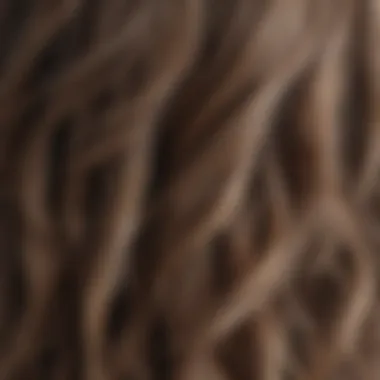Madison Reed: Expert Solutions for Gray Hair Coverage


Intro
Gray hair can be a sign of wisdom, but many prefer to cover it for various reasons. Madison Reed offers innovative solutions for addressing this concern. This article provides an in-depth look at how the brand approaches gray coverage. It will cover product effectiveness, application techniques, and consumer experiences.
Madison Reed’s Unique Approach to Gray Coverage
Madison Reed stands out in the hair care industry with its focus on personalized color selection. This approach allows users to find shades that complement their natural hair color. The brand uses a color-matching technology, which is designed to help individuals choose the right hue. This personalization ensures a more natural look when covering grays.
Product Effectiveness
One of the strengths of Madison Reed products is their formulation. They are made without harsh chemicals, which can damage hair. Instead, the brand incorporates nourishing ingredients. The outcome is often a shinier and healthier appearance, which many users appreciate. Moreover, the longevity of the color tends to exceed expectations compared to traditional options.
- Key Product Features
- Free from ammonia and parabens
- Gluten-free and cruelty-free
- Infused with keratin, ginseng root extract, and more
Application Techniques
Proper application is crucial for achieving the best results. Madison Reed provides detailed instructions for users. These instructions often include step-by-step guides. This is helpful for those who are new to at-home hair coloring. Consistency during application can significantly impact the final result. Users are encouraged to take their time.
Tips for Application
- Perform a patch test before using any new coloring product.
- Use a color brush for precise application.
- Section hair to ensure even coverage.
- Follow timing guidelines carefully.
- Rinse thoroughly to remove all product.
User Experiences
Reviews from users highlight both positive and negative experiences. Most commend the product's ease of use and color quality. Many users note it is suitable for all hair types. Some customers, however, found it challenging to achieve the perfect shade on their first try.
As one user stated,
"Madison Reed completely changed how I view hair color. It feels more natural and healthier."
Market Impact and Consumer Choices
In recent years, the market for gray coverage has shifted. Brands like Madison Reed have influenced consumer choices. Many individuals are leaning towards products that offer a healthier option. This trend reflects a growing awareness of personal care ingredients.
Culmination
Madison Reed provides an effective solution for those wishing to cover gray hair. The brand’s focus on personalized color selection, quality ingredients, and user-friendly application sets it apart.
From product effectiveness to application techniques, its offerings cater to a fashion-conscious audience. The impact on the market illustrates a shift toward healthier hair care choices. Whether one desires a subtle change or an entirely new look, Madison Reed presents a compelling option.
Prelims to Madison Reed
In the competitive landscape of hair care, understanding a brand's origins and philosophy provides essential context for its offerings. Madison Reed emerges as a prominent player in the market for gray coverage solutions, recognizing the unique needs of consumers who seek both effectiveness and a sense of style. This section provides insight into the brand's foundation and core principles, which are pivotal for evaluating its products.
History and Brand Philosophy
Madison Reed was founded in 2013 by Amy Errett, who aimed to revolutionize the hair color industry by introducing a brand that prioritizes quality and safety. The company is named after Amy's daughter, symbolizing a personal connection to its mission. Madison Reed positions itself as a direct response to the traditional salon experience, focusing on accessibility without compromising on the rich results that consumers desire.


Central to the brand's philosophy is the commitment to healthier ingredients. Products are crafted without harmful chemicals commonly found in conventional hair dyes. Instead, Madison Reed champions a blend of high-quality formulations and advanced technology. This ensures a more natural product that aligns with the values of health-conscious consumers. The brand also places a strong emphasis on community engagement and education, offering resources for customers to make informed decisions about their hair care.
Target Demographics
Madison Reed primarily targets individuals who are fashion-forward and conscious of their appearance, particularly those aged 30 and above. This demographic often includes working professionals, busy parents, and anyone seeking to cover gray hair effectively while maintaining an elegant look.
Additionally, the brand resonates with consumers who appreciate the balance of quality, convenience, and affordability. Madison Reed's products are designed for both at-home application and professional settings, catering to varying preferences. The brand's digital-first approach appeals to a tech-savvy audience that seeks online resources and support. With its strategies, Madison Reed effectively captures the attention of a market that values personalized solutions, ensuring each customer feels recognized and well-cared for in their journey toward embracing their hair and personal style.
Understanding Gray Hair
Understanding gray hair is essential when discussing solutions for gray coverage. This topic delves into not only the biological aspects of why hair turns gray but also addresses myths that can affect perceptions and choices about hair coloring. By comprehending the underlying science and dispelling common misconceptions, individuals can make more informed decisions when selecting products like those offered by Madison Reed.
The Science of Hair Aging
As people age, it is natural for changes to occur in various bodily functions, including hair pigmentation. The primary cause of gray hair is the loss of melanin, the pigment responsible for hair color. Melanin is produced by melanocytes, which gradually decrease in number and activity with age. Once these cells quit producing melanin, the hair takes on a gray or white appearance.
Other factors influencing hair aging include genetics, environmental stressors, and health conditions. Some individuals may begin to notice gray strands in their twenties or thirties, while others may not see significant graying until much later in life. Understanding this process is vital not only for addressing the aesthetic concerns of gray hair but also for recognizing the normalcy of aging.
Common Myths about Gray Hair
Several myths surrounding gray hair can mislead individuals regarding its management and treatment. Here are some of the prevalent misconceptions:
- Myth 1: Plucking gray hairs causes more to grow. This is false. Plucking does not increase the number of gray hairs; however, it can harm the hair follicle and may lead to more problems in the future.
- Myth 2: Stress causes gray hair. While stress can affect overall health, there is limited evidence linking stress directly to the graying process.
- Myth 3: Only older adults have gray hair. This is untrue. Graying can start at a younger age due to genetic factors, irrespective of a person's overall age.
- Myth 4: Natural hair products do not cover gray hair effectively. Many high-quality brands, including Madison Reed, utilize innovative formulations to provide effective gray coverage.
By debunking these myths, individuals can have a clearer understanding of gray hair and make more educated choices regarding hair coverage solutions. This knowledge is crucial in an age where carefully considered grooming and personal style can significantly impact one's professional and personal life.
Madison Reed’s Approach to Gray Coverage
Madison Reed adopts a unique and comprehensive strategy to address the need for effective gray hair coverage. The brand emphasizes a personalized experience for users, offering products that cater to individual preferences and hair types. This approach not only meets the immediate demand for gray hair solutions but also aligns with broader consumer trends that prioritize quality and tailored experiences. Through a thoughtful selection of ingredients and innovative technology, Madison Reed aims to deliver superior results while enhancing the overall user experience.
Product Line Overview
Madison Reed’s product line is meticulously curated to provide options that address diverse hair needs. The key offerings include:
- At-Home Hair Color Kits: These allow users to achieve professional-looking results from the comfort of their homes. Each kit includes all necessary tools and instructions.
- Color Reviving Gloss: A temporary solution designed to refresh color between applications. It enhances shine and vibrancy.
- Root Touch Up Products: For those periods when an immediate fix is needed, these products help mask grays effectively and are easy to apply.
The design of these products is intentional, focusing on user-friendly application and satisfactory coverage. Furthermore, Madison Reed succeeds in creating a modern aesthetic that appeals to fashion-conscious individuals seeking quality solutions.
Key Ingredients and Their Benefits
Madison Reed is committed to using high-quality ingredients in its formulations. Among the significant components are:
- Coconut Oil: Known for its hydrating properties, it helps in moisturizing the hair, enhancing softness and shine without weighing it down.
- Argan Oil: This ingredient is rich in fatty acids and antioxidants, contributing to healthier hair. It helps in preventing damage and maintains color vibrancy.
- Free of Harmful Chemicals: Madison Reed avoids harsh chemicals like ammonia and parabens, ensuring a gentler coloring experience beneficial for sensitive scalps.
The use of these ingredients allows Madison Reed products to not only cover gray hair but also improve the overall health and texture of the hair, distinguishing them in a crowded market.
Technology Behind the Color
The technology employed by Madison Reed plays a crucial role in the effectiveness of their products. Their formulations utilize a proprietary blend of pigments that provide rich, lasting colors while ensuring even application. Notably, they incorporate:
- Color Technology: This ensures colors stay true over time, resisting fading and maintaining depth.
- pH-balanced Formulations: This characteristic helps to close the hair cuticle post-application, locking in color and reducing damage.


In addition to the formulation technologies, the user interface of Madison Reed’s online shade selector is noteworthy. It allows customers to virtually match their desired shade, enhancing the shopping experience by making it interactive and personalized.
"Using innovative ingredients with a focus on health allows Madison Reed to effectively cover gray hair while promoting hair wellness."
By combining sophisticated technology with user-centered design, Madison Reed stands out in the gray coverage solutions landscape. This ensures that users not only achieve the look they desire but also maintain the integrity of their hair.
Selecting the Right Shade
Choosing the right hair color shade is crucial for achieving a natural-looking aesthetic when covering gray hair. A well-chosen color can enhance one’s features, boost confidence, and maintain a stylish appearance. Missteps in shade selection can lead to contrasting results that may appear artificial or mismatched. Thus, understanding how to select the perfect shade becomes fundamental.
Understanding Undertones
Undertones play an essential role in selecting hair color. They refer to the colors that reside beneath the surface color of the hair. Generally, undertones fall into three categories: cool, warm, and neutral.
- Cool Undertones: These tones often feature hints of blue, violet, or ash. If skin tones are fair with pink hints or darker with olive undertones, cool shades may suit better.
- Warm Undertones: Characterized by golden, peach, or copper hints, warm undertones often pair well with rich, vibrant colors. Individuals with yellow or golden complexions typically look great with warm tones.
- Neutral Undertones: This category often features a mix of the two. Neutral undertones can wear a wider palette of shades, from caramel to ash blondes, making selection a bit easier.
By identifying the undertone of a person’s hair and skin, one can select shades that harmonize well, resulting in a more cohesive appearance.
Personalized Shade Recommendations
Personalized shade recommendations are vital for ensuring customer satisfaction. Madison Reed offers an innovative approach for this aspect by providing tailored color consultations. Here are a few key points:
- Consultation Tools: Madison Reed's online consultation tool assesses a person’s hair history and preferences. This enables users to receive custom suggestions based on their specifics.
- Color Swatches: Viewing color swatches online provides an idea of how different shades would look in natural light. Purchasing a sample set for testing can be helpful before committing to a full-color application.
- Expert Guidance: The brand employs color experts who guide customers through the selection process. Such insights leverage knowledge about current color trends, ensuring consumers make informed choices.
"The right shade does more than cover gray; it also enhances facial features and personal style."
Failing to pay attention to these personalized elements can lead to dissatisfaction. Therefore, Madison Reed's meticulous approach helps customers feel more in control of their hair coloring journey.
Application Techniques
Understanding the various application techniques is key for achieving the desired results when using Madison Reed products. These techniques can significantly impact the effectiveness of gray coverage, the convenience of the process, and the overall user satisfaction. Knowing how to apply color properly is essential not only for achieving a natural appearance but also for minimizing damage to the hair during the process. Moreover, effective application techniques can empower users to take control of their hair coloring experience, leading to better results and greater confidence in their choice of color.
In-Depth Guide to Home Application
When considering home application of Madison Reed products, it's imperative to follow a systematic approach to ensure optimal results. Here are some important steps to consider:
- Preparation: Before applying any color, start by reading the instructions provided in the kit thoroughly. Ensure that the work area is well-lit and that you have all necessary tools, including gloves, a brush, and clips.
- Allergy Test: It’s prudent to conduct a patch test at least 48 hours before full application. This will help determine if there will be any adverse reactions to the product.
- Applying the Color: Divide the hair into sections. This makes it easier to apply the product evenly. Begin applying at the roots, as this area often needs more processing time. Use a brush for precision, and ensure that every strand is coated.
- Timing: Follow the timing guideline indicated in the instructions. If unsure, it's safer to err on the side of caution and rinse earlier rather than risk over-processing.
- Rinsing: Rinse the hair thoroughly with lukewarm water until the water runs clear. Follow up with the conditioner included in the kit to seal in moisture.
This step-by-step approach can greatly enhance the results of home application and provide a seamless experience for those engaging in at-home hair color applications.
Professional Application Options
While home application may be sufficient for many, some individuals may prefer or require the expertise of a professional. When considering professional application options, it's beneficial to evaluate the following:
- Salon Expertise: Salons offer trained professionals who understand hair types and can cater the application to individual needs effectively. They can personalize the coloring process, increasing satisfaction with the results.
- Advanced Techniques: Professionals may employ techniques such as balayage or highlights that may be difficult to replicate at home. These methods can create a more dynamic look while effectively covering gray hair.
- Color Matching: A hairdresser can better assess undertones and can recommend specific shades from Madison Reed's range that best suit personal features, ensuring a more flattering and cohesive appearance.
- Time Consideration: Professional applications may take longer but provide peace of mind knowing experts handle the process, often resulting in a more polished finish.
In summary, while home applications can be very effective when followed correctly, professional options offer both expertise and advanced techniques that can elevate the overall experience of using Madison Reed products. Understanding these options is essential for any man who values style and is seeking effective solutions for gray hair coverage.
User Experience and Feedback
User experience and feedback are crucial aspects of understanding any product, especially in the hair color industry. For Madison Reed, these elements help shape future offerings and improve the overall user journey. When customers share their experiences, they provide insights that can be used to enhance formulas, application methods, and customer service.


A positive user experience leads to customer loyalty and repeat purchases. It can also encourage word-of-mouth referrals. Therefore, analyzing feedback allows Madison Reed to fine-tune its products and services according to the preferences and needs of its target demographic. This is essential in the market, where competitors abound and fashion-conscious consumers have high expectations.
Real User Testimonials
User testimonials offer a window into the real-world effectiveness of Madison Reed products. Many users report satisfaction with the ease of application, vibrant color choices, and natural-looking results. Here are notable points from testimonials:
- Ease of Use: Many users highlighted how simple it was to apply the color at home without professional assistance.
- Long-Lasting Results: Several customers mentioned that the color maintained its vibrancy longer than other brands they had previously used.
- Natural Ingredients: Users appreciated the brand's focus on healthier formulations, which made the coloring experience feel less damaging to their hair.
"I was surprised at how easy it was to achieve salon-like results at home. The color lasted for weeks and looked so natural!"
— A satisfied Madison Reed customer.
Before and After Comparisons
Before and after comparisons serve as compelling visual evidence of the effectiveness of Madison Reed's products. Many users share their transformation journeys online, showcasing the impact of the hair color.
The stark contrast in these images often speaks volumes:
- Coverage and Saturation: Photos typically demonstrate excellent gray coverage, presenting a smooth transition from gray to a rich, vibrant color.
- Condition of Hair: Observations often show that hair appears healthier and shinier after the application, standing in contrast to the dull look sometimes seen after coloring with other brands.
Such comparisons not only validate user experiences but also help potential customers envision what the product can achieve for them. By focusing on these real-life results, Madison Reed can differentiate itself in the competitive landscape of hair coloring.
Comparing Madison Reed with Competitors
When it comes to hair color products, consumers face an array of options from various brands. Therefore, assessing how Madison Reed compares with its competitors becomes very essential. Understanding this comparison not only sheds light on Madison Reed's unique offerings but also helps consumers make informed choices about gray hair coverage solutions.
Madison Reed has established itself as a notable player in the market by focusing on quality ingredients, effective results, and a customer-centric approach. Comparisons with competitors highlight what sets the brand apart and reveal insights on aspects like product history, pricing strategies, and customer service that may influence purchasing decisions.
Market Positioning
Madison Reed positions itself distinctly in the hair color sector by targeting consumers looking for upscale and effective gray coverage without compromising on the health of their hair. The brand emphasizes personalized services, often using technology to recommend shades tailored to individual consumers' needs. This personalized experience is significant in a market often dominated by one-size-fits-all products.
Moreover, Madison Reed's focus on salons and home application adds to its positioning appeal. It caters to both professional users and DIY enthusiasts alike, broadening its market reach. Competing brands may target specific demographics or focus solely on either home coloring systems or professional solutions, thus missing the multifaceted approach of Madison Reed.
Product Effectiveness Assessment
Evaluating the effectiveness of Madison Reed's products relative to competitors involves analyzing various factors like color durability, application ease, and user satisfaction. Madison Reed uses high-quality ingredients that not only cover gray but nurture and strengthen hair. This approach contrasts with many traditional brands that may rely on harsher chemicals, potentially damaging the hair over time.
- Color Longevity: Madison Reed users frequently report longer-lasting color. Many finds that colors remain vibrant for weeks, even with frequent washing.
- Ease of Use: The application process designed by Madison Reed often leads to simpler and mess-free experiences, a crucial factor for home users.
- User Satisfaction: Testimonials indicate high satisfaction rates, especially about the color match and overall hair health post-application.
Research shows that effective product performance significantly influences brand loyalty. Madison Reed's commitment to quality ensures that users are not only satisfied but also likely to return for repeat purchases.
The competitive analysis of Madison Reed against its rivals underscores its unique market positioning and effectiveness. By understanding these crucial elements, consumers can navigate the crowded hair coloring landscape with more clarity.
Closure
In summarizing Madison Reed's approach to gray coverage solutions, it is vital to recognize the significance of effective hair color products in today's world. The challenges of gray hair often extend beyond aesthetics; they reflect personal choices and identity. Madison Reed’s innovation not only addresses these challenges but also embraces the notion of information, customization, and user satisfaction.
The Future of Hair Color Solutions
The evolving landscape of hair color is marked by technological advancements and consumer preferences. As people seek solutions that are both effective and aligned with their lifestyle, Madison Reed positions itself as a leader in this area. The future of hair color solutions will likely involve further integration of personalized recommendations, advanced formulations, and sustainability practices.
- Continued Research: Ongoing studies into hair health and color formulation will enhance product performance.
- Sustainability: Many consumers are looking for environmentally responsible options. Brands that prioritize eco-friendly ingredients and packaging can capitalize on this trend.
- Technology Integration: The use of apps for virtual try-ons and color consultations will streamline the process of choosing the right shade.
"Customization is key in the modern hair care market. The more personalized the solution, the higher the consumer satisfaction and loyalty."
Final Thoughts on Madison Reed’s Impact
Madison Reed's influence in the market extends beyond just providing quality products.
- It has elevated the conversation around gray hair coverage, promoting a more nuanced understanding of beauty and aging.
- The emphasis on user reviews and experiences provides transparency.
- Customers feel empowered to make informed decisions about their hair care choices, which builds trust in the brand.















